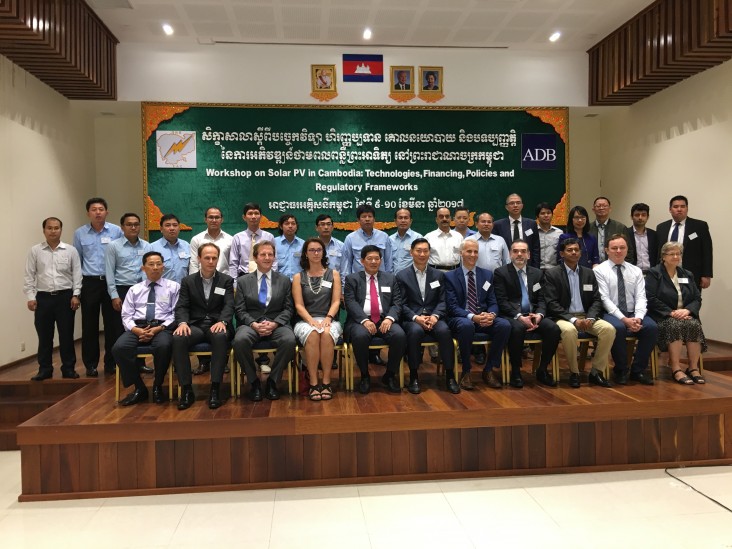Speeches Shim

(as prepared for delivery)
- H.E. Dr. Ty Norin, Chairman and Secretary of State, Electricity Authority of Cambodia
- H.E. Keo Rattanak, Managing Director, Electricité du Cambodge
- Mr. Pradeep Tharakan, ADB Senior Energy Advisor
- Representatives of Electricity Authority of Cambodia (EAC), Ministry of Mines and Energy (MME), Electricite du Cambodge (EDC), National Council on Sustainable Development
Good Morning Excellencies, Ladies and Gentlemen. For the past 3 years, I have been touched by the country’s beauty, its rich culture, industrious people, incredible natural resources, and its abundance of sunshine. That sunshine is what brings us here today.
The solar power industry in Cambodia is at a nascent stage, but it has a very bright future. This workshop will demonstrate that solar energy is already economically viable in Cambodia and can boost the supply of energy during the dry season. We are here today to build the foundation that will help solar power become a significant contributor to Cambodia’s energy security. This workshop will also review the technology needed to connect solar energy into Cambodia’s grid. It will look at the technological options and cost for various types of solar energy Photovoltaic, otherwise known as “PV.” Finally, this workshop will help us promote clean energy investment in Cambodia.
As we all know, Cambodia’s electricity consumption has been increasing in pace with its rapid economic growth, most notably in the electricity-intensive garment sector. However, in order to help Cambodia meet its 2030 goal of Middle Income Status, electricity production must be increased. The Cambodian government forecasts that its power supply will need to increase more than four-fold from 2015 to 2030. That means going from 4,000 to nearly 18,000 gigawatt hours each year for the next 15 years!
To meet this massive objective, the National Development Plan sets out four priorities for developing Cambodia’s power sector. One priority is to boost production from clean energy sources, further encouraging private sector investment, and increasing access to power. So far, Cambodia has made steady progress towards its overarching electricity access targets of 100 percent electrified villages by 2030, with 62 percent connected to date. But now is the time to take advantage of the clean power options so readily available in this sun-drenched country.
At the U.S. Embassy in Phnom Penh we plan to install a ground arooftop PV system that will be completed later this year. The solar power generated from the system will have a capacity of 300 kilowatts and will meet up to 15 percent of the Embassy’s load.
Renewable energy is a priority for us and, through USAID Clean Power Asia, we will support the development, adoption and implementation of policies and regulations that reflect this in the lower Mekong region. USAID Clean Power Asia is a regional program that scales up investment in grid-connected renewable energy power plants throughout the ASEAN member countries. The program operates with a specific focus on the Lower Mekong countries of Cambodia, Lao PDR, Thailand and Vietnam. It will help the Cambodian government develop the best policies, regulations, and standards to promote investment in solar energy throughout Cambodia, including solar farms and rooftop PV.
We are also delighted to partner with ADB to support the promotion of solar power by the Cambodian government. Cambodia has extensive solar resources and expertise at hands. We look forward to hearing the results of the ADB-funded study conducted with the Electricity Authority of Cambodia. This study identified potential projects for ADB financing that can quickly come on board and improve reliability - without major investments - in the grid. With this study, and the additional information that will be presented, we are sure you will leave this workshop with needed knowledge and a greater commitment to solar energy serving a larger share of Cambodia’s future power supply.
Our partnership with ADB and the Cambodian government to unlock the tremendous potential of solar PV in Cambodia is one of many steps to achieve these goals of clean renewable energy for the development of Cambodia. Once again, I want to acknowledge everyone who has taken the time to attend this event.
Thank you and have a productive discussion.
Related Speeches
- Remarks by Menglim Kim, Project Management Specialist, USAID/Cambodia, USAID Greening Prey Lang Final Youth Debate
- Remarks by Ms. Hanh Nguyen, Deputy Mission Director USAID/Cambodia, Health Professional Councils’ Strategic Planning Orientation Workshop
- Remarks by John Eyres, Director, Office of Public Health and Education, USAID/Cambodia, Dissemination Workshop of the Fifth National Strategic Plan for a Comprehensive & Multi-sectoral Response to HIV & AIDS in Cambodia

Comment
Make a general inquiry or suggest an improvement.